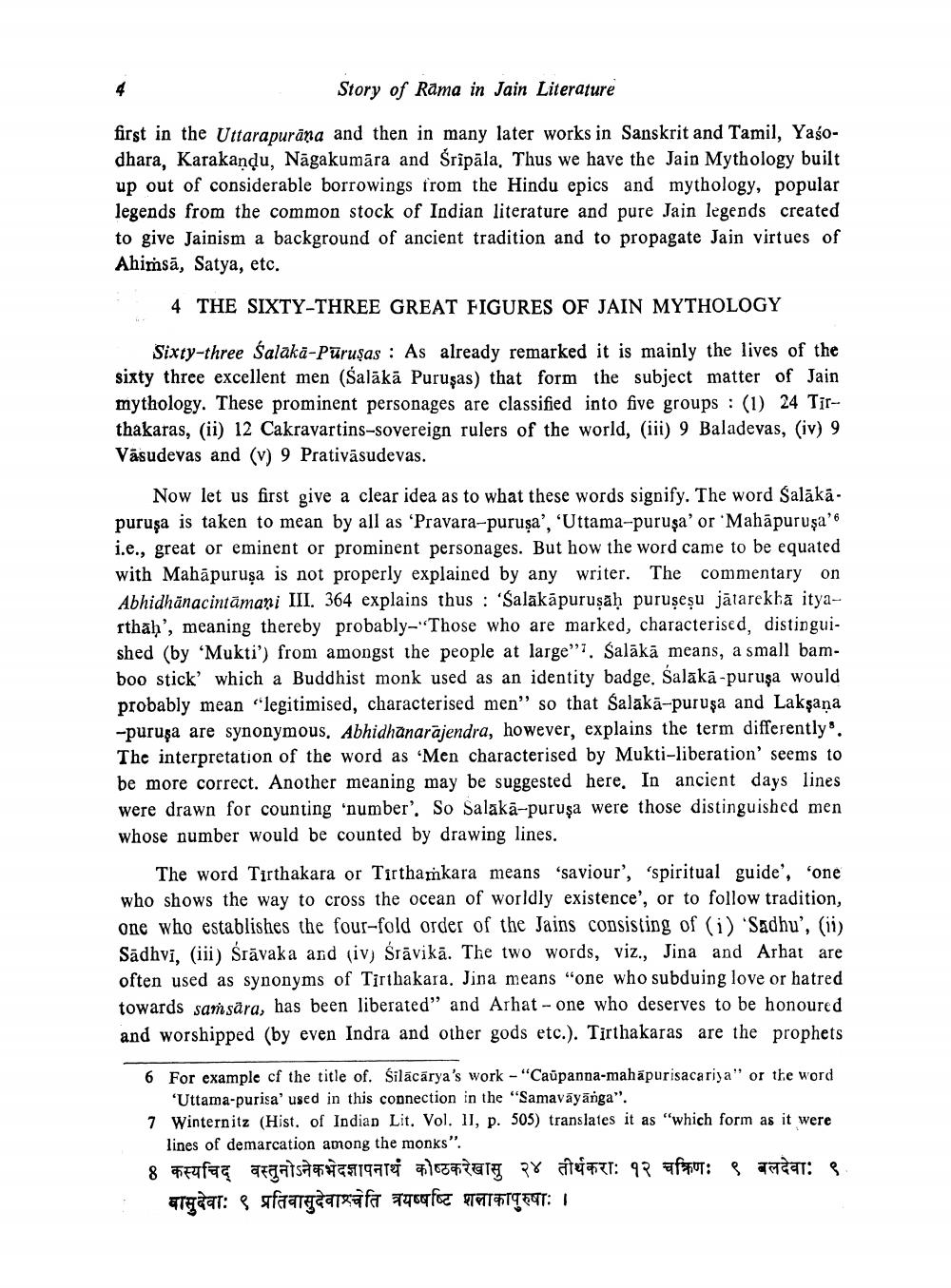________________
Story of Rama in Jain Literature
first in the Uttarapurana and then in many later works in Sanskrit and Tamil, Yagodhara, Karakandu, Nagakumāra and Sripāla, Thus we have the Jain Mythology built up out of considerable borrowings from the Hindu epics and mythology, popular legends from the common stock of Indian literature and pure Jain legends created to give Jainism a background of ancient tradition and to propagate Jain virtues of Ahimsa, Satya, etc.
4 THE SIXTY-THREE GREAT FIGURES OF JAIN MYTHOLOGY
Sixty-three Salaka-Pürusas: As already remarked it is mainly the lives of the sixty three excellent men (Salākā Purusas) that form the subject matter of Jain mythology. These prominent personages are classified into five groups: (1) 24 Tirthakaras, (ii) 12 Cakravartins-sovereign rulers of the world, (iii) 9 Baladevas, (iv) 9 Vasudevas and (v) 9 Prativasudevas.
Now let us first give a clear idea as to what these words signify. The word Salākā. puruşa is taken to mean by all as 'Pravara-purusa', 'Uttama-puruşa' or 'Mahapurusa" i.e., great or eminent or prominent personages. But how the word came to be equated with Mahāpuruşa is not properly explained by any writer. The commentary on Abhidhänacintamani III. 364 explains thus: 'Salakāpuruṣaḥ puruşeşu jātarekha ityarthab', meaning thereby probably-"Those who are marked, characterised, distingui shed (by 'Mukti') from amongst the people at large", Saläkä means, a small bamboo stick' which a Buddhist monk used as an identity badge, Salaka-puruşa would probably mean "legitimised, characterised men" so that Salaka-puruşa and Laksana -purua are synonymous, Abhidhanarajendra, however, explains the term differently. The interpretation of the word as 'Men characterised by Mukti-liberation' seems to be more correct. Another meaning may be suggested here. In ancient days lines. were drawn for counting 'number'. So Salaka-puruşa were those distinguished men whose number would be counted by drawing lines.
The word Tirthakara or Tirthankara means 'saviour', 'spiritual guide', 'one who shows the way to cross the ocean of worldly existence', or to follow tradition, one who establishes the four-fold order of the Jains consisting of (i) 'Sadhu', (ii) Sadhvi, (iii) Śravaka and (iv) Śravika. The two words, viz., Jina and Arhat are often used as synonyms of Tirthakara. Jina means "one who subduing love or hatred towards samsära, has been liberated" and Arhat - one who deserves to be honoured and worshipped (by even Indra and other gods etc.). Tirthakaras are the prophets
6 For example of the title of. Silācārya's work - "Caupanna-mahapurisacariya" or the word 'Uttama-purisa' used in this connection in the "Samavāyānga".
7 Winternitz (Hist. of Indian Lit. Vol. 11, p. 505) translates it as "which form as it were lines of demarcation among the monks".
8 कस्यचिद् वस्तुनोऽनेकभेदज्ञापनार्थ कोष्ठकरेखासु २४ तीर्थंकराः १२ चत्रिणः ९ बलदेवा: ९ argèar: e sfaurgèarifa aquafez garagear: 1




